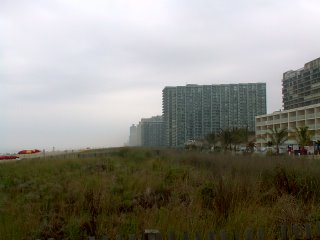
Paradox
I think I have this right. The government organization charged with attracting people to the Outer Banks invited a speaker, who has told people not to come to the Outer Banks, to speak to leaders of the Outer Banks. When he came he told the group that people wouldn't come to visit the Outer Banks because too many people are coming to visit the the Outer Banks. Do I have this right? The upshot is that the Outer Banks Visitors Bureau wants us to adopt policies that will make us look like a place where not many people come to visit so that a lot of people will come to visit.
That's my take on the lead article in the
NC section of the Va. Pilot on Thurs.. The artilce reports on a speach by Jonathan Tourrellot (ryhmes with tours a lot) the geo-tourism editor of National Geographic. Mr. Toursalot ( I mean Tourrellot, is this really his name??) doesn't like the way the Outer Banks has developed, whats more the geo-tourism experts that Mr. Toursalot works with don't think much of it either. This we found out in 2004 in a geo-tourism evaluation of about
150 tourist destinations published in National Geographic Traveler. This survey did not treat the Outer Banks well. It showed us at the top of the bottom third of desitnations. The implication is that we are trending away from the "good" things in geo-tourism.
[Toursalot} said the area is primarily a rest-and-relaxation destination. “But,” he told the audience at Wright Brothers Centennial Pavilion, “what’s important about this place is there’s a lot of heritage and a lot of other cultural assets. That makes this different.”
A global survey of more than 200 specialists in sustainable tourism and destination quality, published in March 2004 in the traveler magazine, gave the Outer Banks a score of 52, with 100 being the best. Experts rated the aesthetics and tourism management as bad and gave a warning on environmental conditions. [snip]
With giant houses taking over the horizon and chain restaurants and stores replacing the quirky momand-pop establishments on the Outer Banks, tourists are taking note, Tourtellot said as he read some of their recent comments: “junk tourism,” “abuse of the word ‘ecotourism’ to promote visitation,” “grossly overdeveloped,” “massive second home development.”
I tend to be a little suspicious of this type of survey. I think you can find a better view what the editior thinks of the Outer Banks if you go back a little further in his magazine and find his piece written about the Outer Banks. Entitled "
Fight Urban Sprawl" It bashes what the author refers to as "KittySnag" the strip running from Kitty Hawk to Nags Head. He stays at the FIrst Colony Inn, which he likes, but finds the the rest of the area less than pleasing
Acres of parking lots surround shopping centers and outlets and real-estate offices and stores selling T-shirts, coolers, kites, and seashells labeled "Product of the Philippines." Driving the bypass, you get a kind of franchise déjà vu: Food Lion, Exxon, BrewThru, Food Lion, Exxon, BrewThru. At night, over-lit businesses and unshielded floodlights on hundreds of rental houses keep the sky pale. Worst offender: The glass-wrapped beach-gear stores called Wings, each pouring out enough candlepower to light up a baseball diamond. Seashore romance? Here your nighttime walk on the sand is not by starlight, but by electric sky glow.
What, pray tell, does our frequent traveller like. Any guesses?
Now skip 90 miles south, to Ocracoke, a village on the sound side of a barrier island accessible only by ferry. Here, you can walk and bike on narrow lanes past charming houses. While relaxing at a harbor-side lunch table, you can watch pelicans and fishing boats.
Surprise, Surprise, I like it too. In fact its where I go on vacation, but Nags Head wasn't an old fishing village, it has been a place where tourists have come since the mid 1800's. We were what we are only smaller. Any attempt to make us into some kind of Colonial Williamsburg period piece is just phony. People have been selling beach supplies to tourists for a long time. This is our heritage Johnathan, get over it.
Actually I agree with some of the comments about overdevelopment (he did spot Wings) but I have a really hard time with the pretentious approach. He doesn't like local stores selling shells from the Philipines in Nags Head but has no problem with the same shells in Ocracoke. I wonder how he would react to an industry that harvested local shells from the beach for resale in Nags Head shops, kind of a large scale Nellie Myrtle Pridgeon business. My guess is he would object. He doesn't like Exxon or Brew Thru even though these businesses are locally owned and some dating back to well before anyone thought about over-development (Stop & Shop in KDH, Stop Quik in Nags Head, Kitty Hawk Exxon in KH). Brew Thru is nothing if not quirky, a t shirt store mascarading as a drive through convenience store, where else do you see that? In the Virginian Pilot article Toursalot sites
" chain restaurants" as another precursor of our impending doom. I count 3 of them (french fry alley doesn't count, there hasn't been a new fast food place built in many years) on the Outer Banks, two at the OB Mall. neither of which look like their base chain building, neither of which even have free standing signs. I compare that to the nearly 100 locally owned restaurants that blanket the Outer Banks and I don't see Armegeddon just yet. There is so much that I don't like about his guy that I need to stop and explain how I think we can solve the problem. If you want more you can
read an excellent speach he gave somewhere about what geo-tourism is and how it works. Note the section about the transition from R&R tourism to Entertainment tourism this is a shift we need to guard against.
Let me first say that I like Carolyn McCormack. I think she has done a good job promoting the Outer Banks and the Visitors Bureau is a pretty progressive organization, after all they brought us Mr. Toursalot,
BUT if we really want fewer visitors then lets promote less, if we want to promote open space and envriomental conservation lets spend more on those values. In fact lets reverse the ratio of spending for the Visitors Bureau. Lets take the one-third of their revenue that is supposed to go to providing tourist infrastructure and make that the promotion budget then lets take the nearly $2,000,000 annually they get for promotion and use it to buy land for open space, reduce congetstion, install stormwater systems that reduce pollution, promote proper maintenance of septic tanks and promote sustainable tourism by starting home businesses to build beach chairs in Colington.
Secondly, lets stop promoting the Outer Banks completely and start to promote our individual communities. Some areas have done it better than others yet we all pay the price. Why should Duck by tarred by the commercial mess of the bypass in Kitty Hawk and KDH. Why should Nags Head get hung with the traffic problems of Southern Shores and Duck. And why should any of us be blamed for the travesty that is Corolla, (so many houses, so little land, see the photo above) Lets start some competition amongst areas for travel dollars, lets make areas responsible for their choices rather than spending dollars earned by the popular places to promote those that just don't get it. If the Outer Banks is getting a bad name then change it and make sure that ol' Toursalot can recognize the difference between South Nags Head and condo row in Kill Devil Hills.
Let me start again. If the OBVB really thinks that Mr. Tourtellot is right then they need to convene a major local conference on sustainability and make sure that it gets attended not just by the effete editor of the National Geographic but experts who can address the specific problems we face, the conference shouldn't just talk about how bad the area is but it should yeild a list of objectives that communities can take home and work on. It must also yeild consenus not just within local governement but including the business community that this really is the goal we want to pursue. Finally, the conference should identify funding sources for the objectives that come from it. They should do this because In the end Tourellot and the Visitors Bureau are right, we are threatened by our success but we are far from ruined by it and if we have leadership not lip service from the Visitors Bureau, maybe we can sustain that success and not succumb to it.
PS. For an interesting observation on Fla (and the Outer Banks?) read
this column from Mr. Tourtellot written in 2003. Do we use tourism in the same manner?



















